Dr Manuela Schiek’s research at the University of Oldenburg involves studying the latest improvements in sustainable production of photovoltaics using confocal laser scanning microscopy. The research describes the use of alternative materials for solar cell manufacture such as organic semiconductors within the energy-capturing active layer, and a transparent electrode made up of a silver nanowire mesh embedded in an organic polymer matrix.
Surface analysis techniques provide in-depth insights into the mechanisms of solar cells, due to their complex multi-layered structure. Although atomic force microscopy (AFM) and tactile profilometry have been widely employed in surface metrology for many years, 3D confocal laser scanning microscopy (CLSM) has now become a popular technique.
The 3D CLSM has the ability to produce detailed, true-color optical images along with the non-contact capabilities of laser scanning technology. It is a rapid technique that is more efficient than stylus-based techniques, allowing simple measurement of soft or adhesive surfaces at a 0.2µm resolution.
Combining such benefits, the recent introduction of an Evident LEXT OLS4100 3D confocal laser scanning microscope in Dr Schiek’s laboratory has significantly improved the accuracy and efficiency of their alternative photovoltaic manufacture research.
Organic Solar Cell
A typical organic solar cell architecture consists of a photon-harvesting active layer sandwiched between two electrodes, one of which is transparent to allow light penetration. Photons that strike the organic conductor produce charge-carrying excitons, which are then separated by an electron donor and an electron acceptor into separate electron and holes. The electrons and holes travel toward their respective electrodes with the application of electrical field, creating the charge separation necessary for producing an electrical circuit.
Dr Schiek’s research focuses on the use of a transparent silver nanowire (AgNW) mesh electrode in the place of the brittle and rare indium tin oxide (ITO), and making the active layer from organic materials, instead of the environmentally damaging chemicals that are currently used. These organic materials also enable the possibility of flexible, sustainable and inexpensive thin-film solar cells for consumer applications.
The active layer is generally a combination of two materials – a polymer and a fullerene. Metal semiconductors are the building blocks with properties that can be adjusted through small changes in the structure to improve solar cell function.
Squaraine dye, as shown in the Figure 1, is one such interesting molecule with structure that provides a broad absorption in the red region of the light spectrum. In Dr Schiek’s laboratory, a bulk heterojunction active layer formed from squaraines with a fullerene acceptor is investigated.
In addition, accurate measurement of layer thickness is equally important. During the research, a scratch is made through the active layer surface using a fine needle, and the step edges are measured using profilometry.
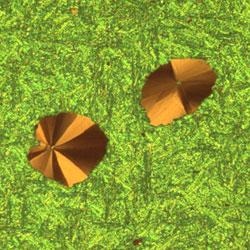
Figure 1. A spincoated layer of neat squaraine, with spherulite aggregates forming through crystallisation upon thermal annealing
In 3D confocal laser scanning microscopy, a laser scans the surface. This kind of non-contact approach provides greater accuracy of surface profilometry, which is shown in the Figure 2A. With the use of LEXT OLS4100, the obtained results can be easily compiled into a report showing the image with respect to the numerical data. Figure 2B shows the data compiled into a report.
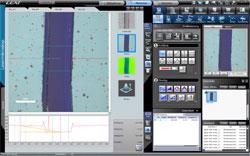
Figure 2A. Non-contact profilometry is here achieved with the Evident LEXT OLS41
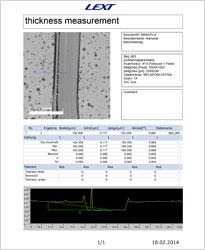
Figure 2B. Data compiled into a report
Transparent Electrodes
Transparent electrodes need to combine optical transparency with conductivity, in order to act as the anode of the solar cell whilst allowing the passage of light through to the active layer.
The rapidly diminishing resource of ITO is currently used as the industrial standard for transparent electrodes. Graphene may be potential alternative, as shown in Figure 3. However, the flakes of the multilayer graphene are quite small limiting their use for large area applications.
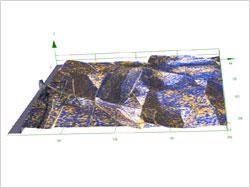
Figure 3. Flake of multilayer graphene coated with a light emitting organic semiconductor
Another promising alternative to ITO and graphene is a silver nanowire mesh (AgNWs) embedded in the polymer matrix. Dr Schiek’s research involves the production of AgNWs, and the subsequent processing to form the electrodes to integrate into organic solar cells.
When using AgNWs as active layers, it is important to prevent aggregation. Puncturing of active layer can also be an issue, as the diameter of AgNWs at 100nm is equal to the active layer thickness.
In practice, however, it is difficult to evenly coat the whole solar cell with the spin-coating production techniques. Evaluation of surface roughness plays a major role in optimizing the synthesis protocol.
Using the LEXT OLS4100, Dr Schiek found that AgNW mesh appeared to be evenly distributed on a small scale - however, the regions of aggregation can be easily identified by producing high-resolution images of one mm2 as shown in the Figure 4A and 4B.
The software also allows visualization of the height profile in 3D for both documentation and analysis. In addition, the ability to increase the height of the low-pass filter from 80µm to 800µm ensures indepth analysis of the elevated regions of the silver nanowires.

Figure 4A. Facilitating analysis of nanowire distribution on a larger scale in brightfield
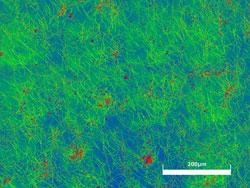
Figure 4B. Height color plot
Conclusion
With widely available resources and latest technological developments, providing a green alternative to a traditional solar cell manufacture is not very difficult.
The Evident LEXT OLS4100 3D confocal laser scanning microscope has provided Dr Manuela Schiek’s research team several benefits over stylus-based methods, from accurate step measurements of the active layer with non-contact profilometry to improved analysis with speed and advanced software functions.

This information has been sourced, reviewed and adapted from materials provided by Evident Corporation - Industrial Microscopy.
For more information on this source, please visit Evident Corporation - Industrial Microscopy